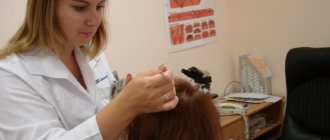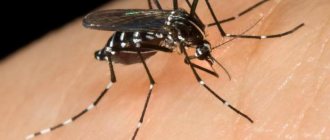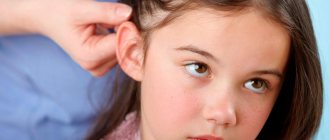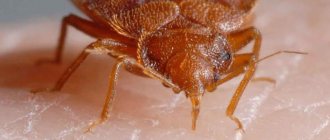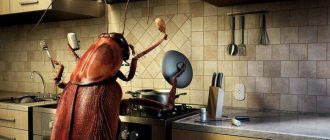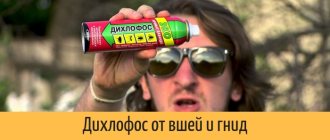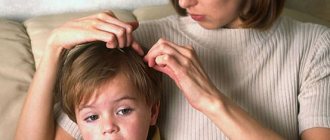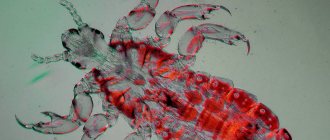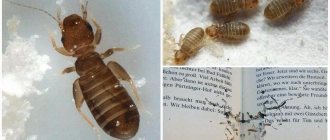What is pediculosis in children?
Pediculosis (in the popular lexicon “lice”) is an infectious disease caused by ectoparasitic blood-sucking insects located in the scalp of the host. The disease is accompanied by painful sensations from lice bites, itching, rash, with the ensuing consequences: scratching and infection of the skin.
A pediatric dermatologist or pediatrician can easily diagnose head lice in children using a visual examination or a special Wood's lamp.
The place of localization during the initial stages of the occurrence of head lice is considered to be the back of the head and temples . With advanced pediculosis, insects parasitize the entire body.
To treat childhood lice, special insecticidal shampoos and preparations are used, for example: Nyuda, Pediculen Ultra, Paranit, Para Plus. Failure to comply with personal hygiene rules and inaction in the event of lice detection can lead to tangled hair caused by insect secretions, the appearance of ulcers and damage to the hair follicles . Nits, empty eggs, lice and their feces appear on the child’s head.
Who is at risk?
Unfortunately, children under the age of 14 are in second place in the age statistics of those infected with head lice. The first place is occupied by persons from 15 to 24 years old , the third – by persons from 35 to 50.
Where do head lice come from in children? There is an opinion that this disease widely spreads to children growing up in socially disadvantaged conditions, but this is far from the case.
Every fifth child, regardless of social class, suffers from head lice ; therefore, almost every child who is in contact with a carrier of the infection is at risk.
Causes
What are the causes of lice in a child? One of the main causes of head lice in children is infection through close contact from a sick child to a healthy one. At first glance, it is impossible to understand whether a child has lice, and prohibiting your child from communicating with peers is simply savagery.
What else causes lice to appear on a child’s head? You can become infected with lice anywhere: at school, kindergarten, in the yard through common hygiene products or while playing. Long and thick hair is most susceptible to this disease.
Lice crawl from their previous owner to a new victim. They lay eggs, reproduce and cause a lot of problems to their new owner.
The average lifespan of one louse is just over a month, during which time the female can lay up to 400 eggs , which become reproductive after two weeks. Children infected with head lice sleep poorly, become nervous and irritable. Severe itching encourages scratching of the scalp until bleeding wounds and crusts form. The cause of head lice in children may also be weakened immunity , which can play a significant role in the development of ectoparasitic insects, as well as unsanitary conditions. You can pick up lice in public transport, in hairdressers, baths, etc.
You can learn about the reasons for the appearance of lice from the video:
How can I tell if my child has lice?
What to do if your child has lice? First, don’t panic and familiarize yourself with the symptoms.
There are certain symptoms:
- Itchy scalp - This is the most common symptom, although if there are not enough individuals (5 or less lice), they may not itch.
- Adult lice - These are small, transparent or white, mobile beetles visible on the scalp or hair. Adult lice are quite fast and therefore more difficult to detect.
- Nits are tiny white eggs that are glued to the hair shaft next to the skin. The nit may contain a live egg or be empty (the egg has already hatched). Nits located close to the scalp are more likely to contain eggs, while those located more than ½ inch from the scalp are likely empty. Nits in a child are often difficult to distinguish from ordinary dandruff in the hair shaft. One way to check is that the dandruff is easily slid off the hair with your fingers and the nits are glued to the hair shaft. How to kill nits? - they do not move from their place so easily, but drugs for effectively combating them will be described below.
Lice larvae photo:
Myths about lice
One of the most common misconceptions that causes head lice in children is the assumption that lice can be transmitted from animals to humans. Animal fleas or lice, of course, can bite a person once or twice, but their main habitat is an animal, be it a cat or a dog or even a parrot.
Read more about the types of lice, how they reproduce, and the incubation period on our website.
Another incorrect rumor that causes lice in children is that head lice occur due to nervousness or severe stress.
Lice are transmitted only from an infected person to a healthy person. There are no other variants of the disease. Even unsanitary conditions do not cause head lice, but only increase the likelihood of contracting an infection.
Cleanliness has nothing to do with it
It is believed that lice is synonymous with uncleanliness. In fact, lice prefer clean and pleasant-smelling hair. You see, it’s easier for them to stick to a clean scalp. Moreover, these insects are known to be attracted to the aroma of good colognes and perfumes. And there is also a version that lice, like many other blood-sucking creatures, perfectly sense the smells of fear and stress, so a person experiencing such emotions (and how many such moments are there in the life of a schoolchild!) becomes especially tasty prey for parasites.
Article on the topic Uninvited Guests. Myths and truth about pediculosis
The louse runs very quickly, covering a distance of 10 cm in a few seconds. Therefore, even short-term contact of heads in a school corridor is enough for a louse to “change its registration.” But nevertheless, these parasites (unlike, for example, fleas) do not know how to jump, so it is impossible to catch an infection by simply passing by a person with lice. You also cannot get lice by playing with a cat, dog or any other animal, since human lice parasitize only on humans.
Why lice may appear again
Why does my child constantly (often) get lice? The reappearance of lice on a child’s head is possible for two reasons:
- From an infected carrier to a child who has already been cleared of parasites. This often happens during an epidemic of head lice, for example in a school or kindergarten group, when treatment was not carried out simultaneously.
- The source of parasites remains due to poor quality treatment or unreliable choice of drugs. Adults die, but eggs may remain unharmed. In this case, after a couple of weeks, viable and reproductive individuals may emerge from the eggs, thereby causing a relapse of head lice.
On our website you will find a lot of useful articles about childhood lice:
- what lice look like on a child’s head: photo with detailed description;
- signs and symptoms of head lice in children: prevention and treatment;
- algorithm of necessary actions when lice are detected in a child;
- specifics of removing lice from long hair in girls at home.
How to avoid lice infestation
There is no absolute prevention. Certain precautions can and should be taken:
- do not visit crowded places with low social responsibility and a low level of personal hygiene - they most often carry parasites, not just lice;
- maintain social distance whenever possible, do not touch your head or hair with other people;
- after visiting places where there was a possibility of picking up lice, be sure to take a shower, wash your hair, and thoroughly comb your hair with a comb or comb; You can use anti-lice products - shampoo, spray;
- regularly inspect children's heads for lice and their eggs;
- do not use other people's personal belongings;
- If you have to use used items that may have body lice on them, wash them at temperatures above 40 degrees, iron them or treat them with a steam generator.
If you can’t protect yourself from lice, you need to start fighting when the first symptoms appear. Modern anti-pediculosis agents allow you to get rid of lice in 1 – 2 applications. We recommend products from MediLis: BIO, Malathion, Permifen, Super. They are suitable for adults and children over 5 years old. The instructions must be strictly followed to ensure that the treatment is effective and safe. Treatment should be with enhanced pediculicides, which destroy not only adult lice, but also nits (scientifically speaking, they are ovicidal). Medilis-BIO is specially designed to combat human lice. The solution is applied for about 20-30 minutes, then the disoriented and dead parasites are combed out using a comb. At the end of the procedure, the hair must be rinsed under running water. Products produced by MediLIS Laboratory LLC help get rid of all three types of lice. To completely get rid of parasites, you need to treat not only the head and body, but also clothing, personal belongings, bedding, furniture, floors, etc., because there may be individual individuals on them. If they are not destroyed, they will reappear on the head, causing a new lice infection. For the same reason, when lice appear in one family member, all household members need to be treated for parasites.
Prevention of head lice
And yet, if a child has lice, what should you do in this case? Compliance with the basic rules that parents should know about will help protect the child as much as possible from lice infection. Prevention of head lice in children involves increasing the sanitary discipline of children, explaining the rules of personal hygiene and cleanliness.
Regular change of bed linen and underwear in conjunction with regular bathing of the child in clean water with appropriate detergents. Washing clothes in hot water and thoroughly cleaning rooms where children are located will help avoid the appearance of blood-sucking insects.
A very important point is the systematic visual examination of children, and if a source of disease is detected, immediate isolation and timely treatment .
Only the parents themselves can save parents from the serious hassle associated with head lice. Take a closer look at your child’s lifestyle and his environment.
Education, including lessons in cleanliness, will help solve numerous issues.
